Family dinners under $10: Three easy egg recipes to whip up for Easter
Sign up now: Weekly recommendations for the best eats in town

(Clockwise from left): Sambal telur, poached eggs with soya sauce and steamed egg tofu with prawns.
ST PHOTOS: HEDY KHOO
Follow topic:
SINGAPORE – Instead of chocolate eggs for Easter, how about whipping up savoury and affordable dishes for your family?
If you have hard-boiled eggs that you have decorated for the occasion, you can repurpose them for a spicy dish of sambal telur.
Although ready-to-use pastes are easily available, I recommend making your own spice paste as you can control the amount of salt and sugar.
But instead of using fresh diced tomatoes, I reach for ketchup to add tang, sweetness and liquid to the final sambal. It shortens the cooking time and cuts back on effort.
I am partial to Del Monte Ketchup for cooking as I find the level of sweetness and viscosity just right.
Recipe for Sambal Telur

Sambal telur.
ST PHOTO: HEDY KHOO
It is best to use eggs that are a week or two weeks old for making hard-boiled eggs. Fresh eggs are difficult to peel when hard-boiled.
Ideally, the eggs need to be deep-fried but, to make a less oily version, I pan-fry the eggs, rolling them around the pan to get as much of their surface fried as possible.
The sambal-coated eggs are so tasty, it is hard to stop at one. This is one dish that you simply have to eat with rice, as the sambal packs some heat.
Ingredients
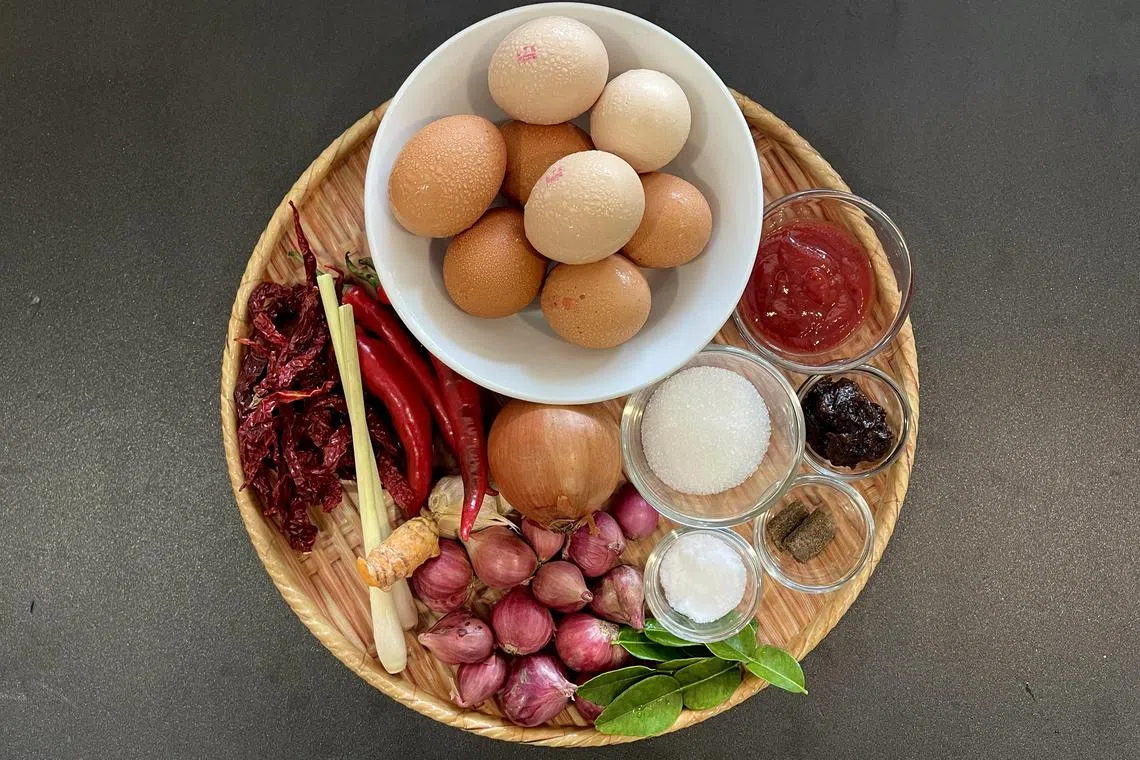
Ingredients for sambal telur.
ST PHOTO: HEDY KHOO
2 litres water (for boiling)
8 eggs (55g each)
1 lemongrass stalk, cut into 5cm lengths
1 yellow onion (150g), sectioned
4 Thai lime leaves
Oil (for frying)
Ingredients for spice paste
24g dried chillies
10g fresh turmeric root, chopped
1 lemongrass stalk, slice up 5cm of the white root part
4 garlic cloves
4 red finger chillies
150g shallots
8g belacan paste
30g sugar
1 Tbs assam jawa (tamarind pulp)
A pinch of salt
90ml ketchup
Method
1. Place the eggs in a pot and add the 2 litres of water.
2. Bring to a boil. Turn off the heat, cover and let the eggs cook in the residual heat for 10 minutes.
3. Remove eggs from the pot and place them in iced water for five minutes.
4. Remove the shells and set aside. Make sure the hard-boiled eggs are dry before frying.
5. Heat 100ml of oil in a deep frying pan.
6. Pan-fry the eggs until golden-brown. Place them on kitchen paper to remove excess oil.
7. Cut the dried chillies in half and shake out the excess seeds. Boil the dried chillies in hot water until softened. Drain the excess water.
8. Grind the dried chillies, turmeric root, lemongrass, garlic, red finger chillies, shallots and belacan paste.
9. In a frying pan, heat 4 Tbs of oil.
10. Turn the heat down to low and add the spice paste.
11. Fry for 15 minutes over low heat, then add the sugar and assam jawa. Season with salt.
12. Remove the spice paste and set aside.
13. In a clean frying pan, heat 2 Tbs of oil, then add the lemongrass stalk, onion and Thai lime leaves.
14. Over medium-low heat, add the spice paste and ketchup.
15. Mix well and cook until the onion turns translucent.
16. Add the fried hard-boiled eggs and toss quickly.
17. Turn off the heat and serve.
Serves four to five
Recipe for Poached Eggs with Soya Sauce

Poached eggs with soya sauce.
ST PHOTO: HEDY KHOO
Poached eggs never go out of style, but instead of making them with Hollandaise sauce, I tried out a recipe of poached eggs with soya sauce which I saw on YouTube. < https://youtu.be/4k6kbqvI8hs
First, you poach the eggs, then prepare a sauce using the poaching liquid.
The key is to start with fresh eggs. I used Dasoon kampung eggs.
I tweaked the recipe a little, adding some white rice vinegar to the poaching liquid. The acidity helps the eggs hold their shape better.
For the final sauce, skip the sugar and vinegar if you find the tang odd. I do like it, though. The slight acidity keeps the eggs from getting cloying.
Have the poached eggs with noodles for a simple, tasty brunch.
Ingredients
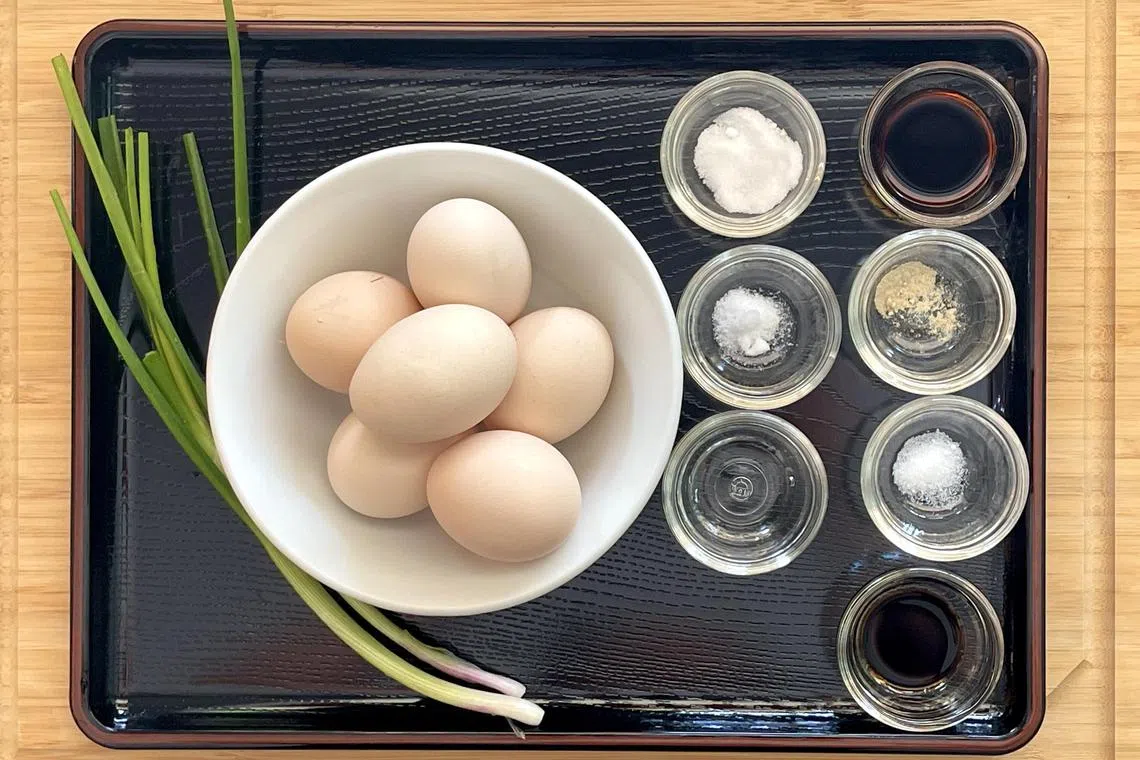
Ingredients for making poached eggs with soya sauce.
ST PHOTO: HEDY KHOO
6 eggs (55g each)
90ml of water
1.5 litres of water (for poaching)
1 tsp salt
¼ tsp white rice vinegar
1 Tbs light soya sauce
⅛ tsp ground white pepper
¼ tsp sugar
½ tsp black rice vinegar
1 tsp sesame oil
2 stalks of spring onion, sliced
Method
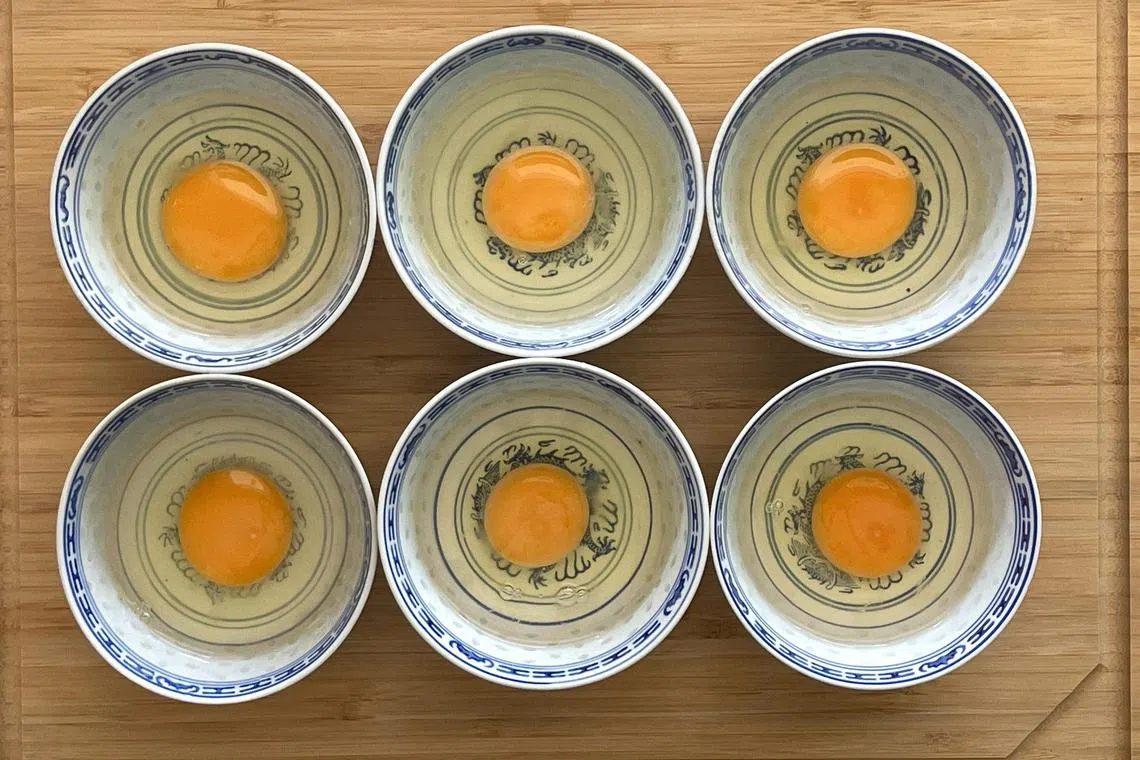
Crack each egg into a bowl with a little water.
ST PHOTO: HEDY KHOO
1. Prepare six bowls. Add 15ml of water in each bowl. Crack one egg into each bowl.
2. In a deep-frying pan, bring the water to a simmering boil. Add the salt and white rice vinegar. Stir the water gently to get rid of the bubbles.
3. Turn off the heat. The water should be still when you add the eggs.
4 Take a bowl with the egg and gently half-submerge the bowl in the hot water, allowing the egg to gently slide into the water. Do the same with the remaining eggs. Cover and turn on the heat to low.
5. After two minutes, use a heat-resistant silicone spatula and gently slide it under each egg to prevent it from sticking to the bottom of the pan.
6. Cover and continue cooking for another two minutes until the eggs are poached, with jammy yolks. Cook for a minute more if you want completely cooked yolks.
7. Gently transfer the poached eggs into a dish.
8. In a deep dish, add the light soya sauce, white pepper, sugar, black rice vinegar and sesame oil.
9. Add 200ml of the poaching liquid.
10. Add the spring onion.
11. Place the poached eggs in the sauce.
12. Serve immediately.
Serves three to four
Recipe for Steamed Egg Tofu with Prawns
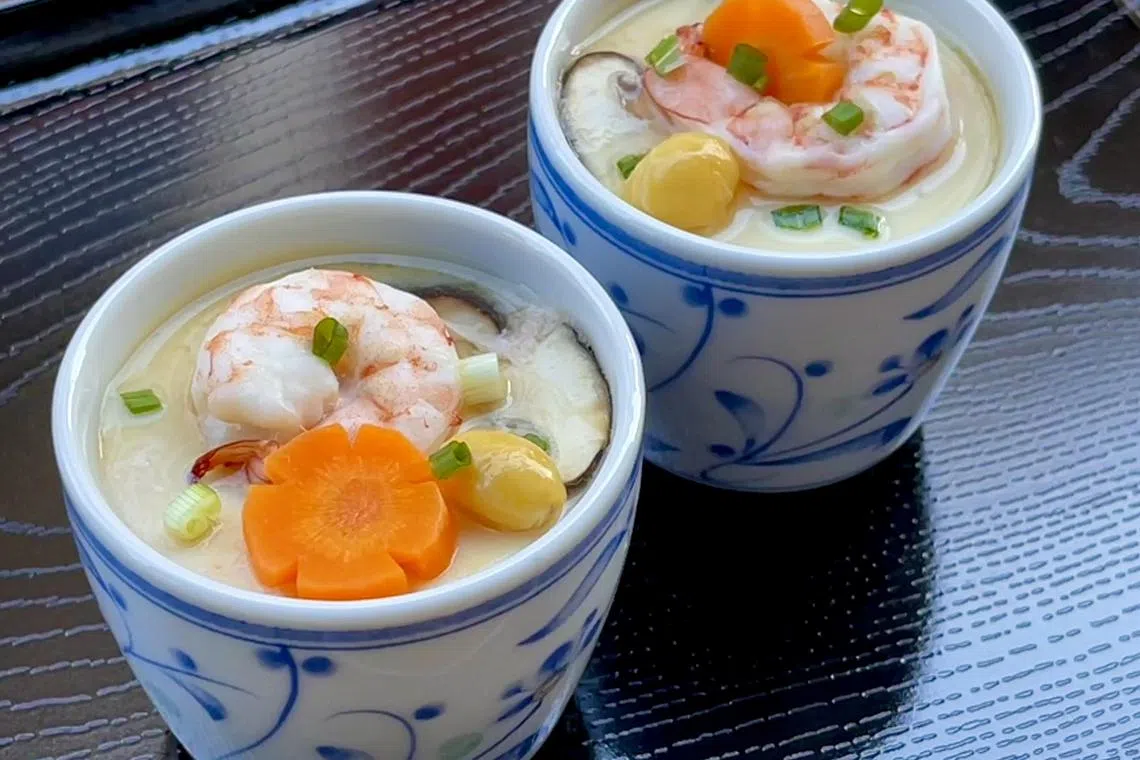
Steamed egg tofu with prawns.
ST PHOTO: HEDY KHOO
If you like chawanmushi, try making a soya milk-based version of it. It is creamier and you can skip the steps for making the dashi or stock. You can get unsweetened soya milk from hawker stalls that sell soya bean milk or from supermarkets. FairPrice Fresh Soya Milk – Unsweetened is priced at $1.97 for 950ml.
For steaming, it is best to use ceramic cups meant for making chawanmushi as they come with lids.
Ingredients
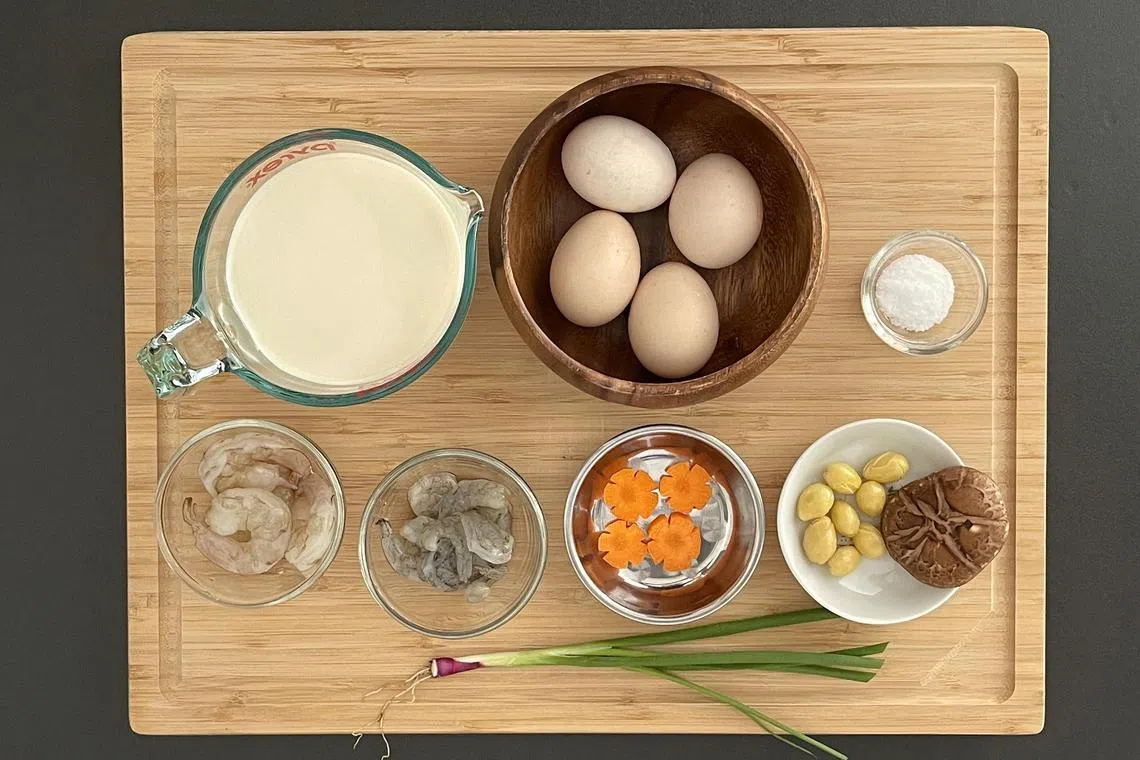
Ingredients for steamed egg tofu with prawns.
ST PHOTO: HEDY KHOO
10 medium-sized prawns (120g), shelled and deveined
200ml water
A pinch of sugar
4 small slices of carrot (12g)
8 canned ginkgo nuts (17g)
4 eggs (55g each)
1 flat tsp of salt
500ml unsweetened soya milk
1 shiitake mushroom, sectioned into eight pieces
1 stalk of spring onion, sliced
Method
1. Keep four of the prawns whole. Take the remaining six and halve them lengthwise. Set aside in the fridge until ready to use.
2. In a saucepan, bring 200ml of water to a boil. Add a pinch of sugar.
3. Add the carrot slices and boil for two minutes until tender. Remove the carrot slices and set aside.
4. Blanch the ginkgo nuts for one minute.
5. In a mixing bowl, crack the four eggs.
6. Add 1 flat tsp of salt and mix gently.
7. Add the soya milk and mix gently.
8. Strain the mixture into another bowl. Transfer into a measuring cup for easy pouring later.
9. Prepare four ceramic cups with lids.
10. In each cup, place three pieces of the halved prawns, one ginkgo nut and two pieces of mushroom.
11. Divide the egg mixture among the four cups.
12. With the heat on low and the water barely simmering, place the cups on a flat steamer plate. Put the lids on the cups. Cover the steamer and steam the cups over low heat for 20 to 21 minutes, until the egg is still wobbly but set.
13. Remove the lids of the cups and, in each cup, place a whole prawn, a ginkgo nut and a carrot slice.
14. Put the cup lids back on and cover the steamer. Continue steaming over low heat for another two to three minutes until the prawns are cooked through.
15. Garnish with spring onion.
16. Serve immediately.
Serves four
Follow Hedy Khoo on Instagram
@hedchefhedykhoo
Go to straitstimesfood.com for recipes, news on the latest food trends, and more. Follow our social media accounts on
Instagram
andFacebook
@straitstimesfood.


